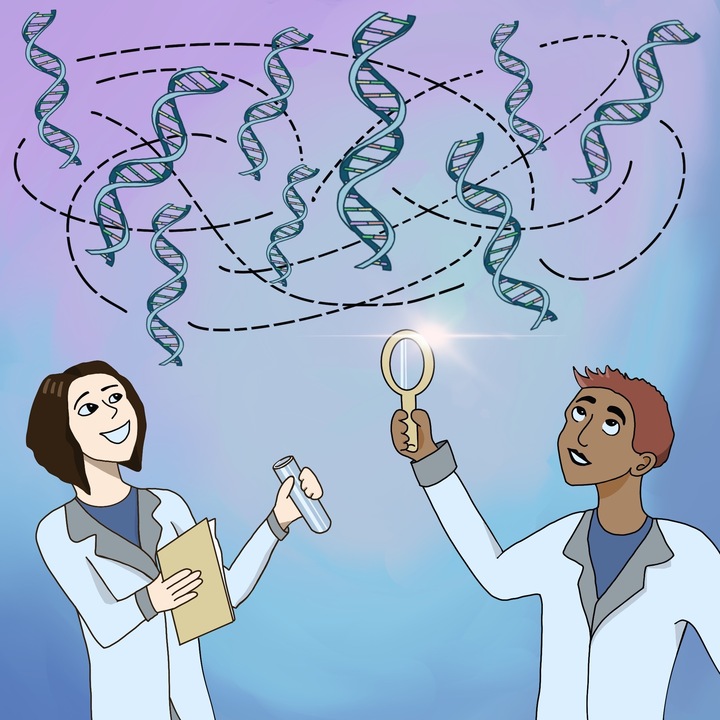Scene
‘Up and Atom!’: The Human Pangenome Project: WashU research captures human genetic diversity

Elliana Lilling | Contributing Illustrator
The Human Genome Project (HGP) was a 13-year, multi-billion-dollar effort that partially took place at WashU, and concluded in 2003 with the creation of the “human genome reference sequence” — a comprehensive map of the DNA found in one human cell. Today, the reference genome is a powerful tool for clinical research, helping to identify the mutations in individual patients’ DNA. However, WashU researchers say the reference genome is due for a major update.
More than 20 years after the conclusion of the Human Genome Project, Dr. Juan Macias and other researchers at Wang Lab in the Department of Genetics and Center for Genome Sciences & Systems Biology are working as a part of the Human Pangenome Reference Consortium (HPRC), an NIH-funded project working to create a reference “pangenome” to capture the full range of human diversity.
“‘You cannot use a single reference!’ I will scream that from the rooftops,” said Macias, who is a postdoctoral researcher at the Wang Lab. While the reference genome remains a cornerstone of genetic research, Macias says it represents only a narrow slice of human diversity.
“[Using the reference genome] is like putting together a jigsaw puzzle,” explained Macias. “We just have the picture on the box, and we’re using it to match the pieces to the picture. The problem is that [a] single picture is not representative of very many individuals.”
Rather than using a single reference of what a human’s DNA should look like, the HPRC seeks to combine the genomes of many individuals into a widely applicable map of human genetics — the pangenome.
Creating an accurate picture of human genetics is no small undertaking. The HPRC’s first draft of a pangenome reference was released in May of 2023, and included nearly complete genome assemblies representing 47 different individuals, each of whom were specifically chosen to achieve the widest possible diversity.
The nature of this pangenome is more than just a big list of genomes to reference; it is a computational map that links genomes together where they share similarities, and branches off where they have differences. For researchers like Macias, modeling the relationships of these genomes poses a unique computational challenge, but the benefits could be instrumental for treating diseases such as cancer and Alhzheimer’s.
In more concrete terms, Macias expressed that the pangenome offers a faster, more effective, and often cheaper way to narrow down genetic loci (specific locations) where genetic variation impacts the body’s ability to fight such diseases.
“I’m particularly interested in understanding how those individual level variations are going to impact our ability to leverage stem cell therapies, iPSCs [induced pluripotent stem cells] in particular, to develop therapeutics in the future.”
In the next draft, HPRC will expand the pangenome to include DNA from more than 200 people, making it far more effective than the first draft at capturing the full diversity of the human population. Macias explains that this kind of reference will become essential for advancing personalized medicine, a primary goal of the NIH.
“It’s clear that it’s going to have a very significant impact. Anything that deals with clinical genetics will be dramatically improved. The problem is how we get people to adopt it, how we teach them to use it effectively and really to leverage the unique beneficial properties of the pangenome.”
In addition to being a monumental project for all of genomics, Macias says that working on the pangenome has also been an engaging and transformative part of his scientific journey. He was pursuing a career in agriculture when he began his PhD at WashU, but soon changed course when he encountered the pangenome.
“My family has a history in agriculture in Mexico, so working in agrotech was sort of a natural connection. But [at WashU] they tell you ‘do rotations and in areas that you’ve never done anything in, because you never know what you might like.’ Turns out, I really like weird, complicated genetics.”
As this project continues, the Department of Genetics, where this research is performed, will celebrate its 50th anniversary with a symposium on April 24. The symposium will feature speakers who were instrumental to the creation of modern genomics, including talks from Robert Waterson, one of the pioneers of the original Human Genome Project, and Eric Green, the director of the National Human Genome Research Institute (NHGRI) and WashU alum.
